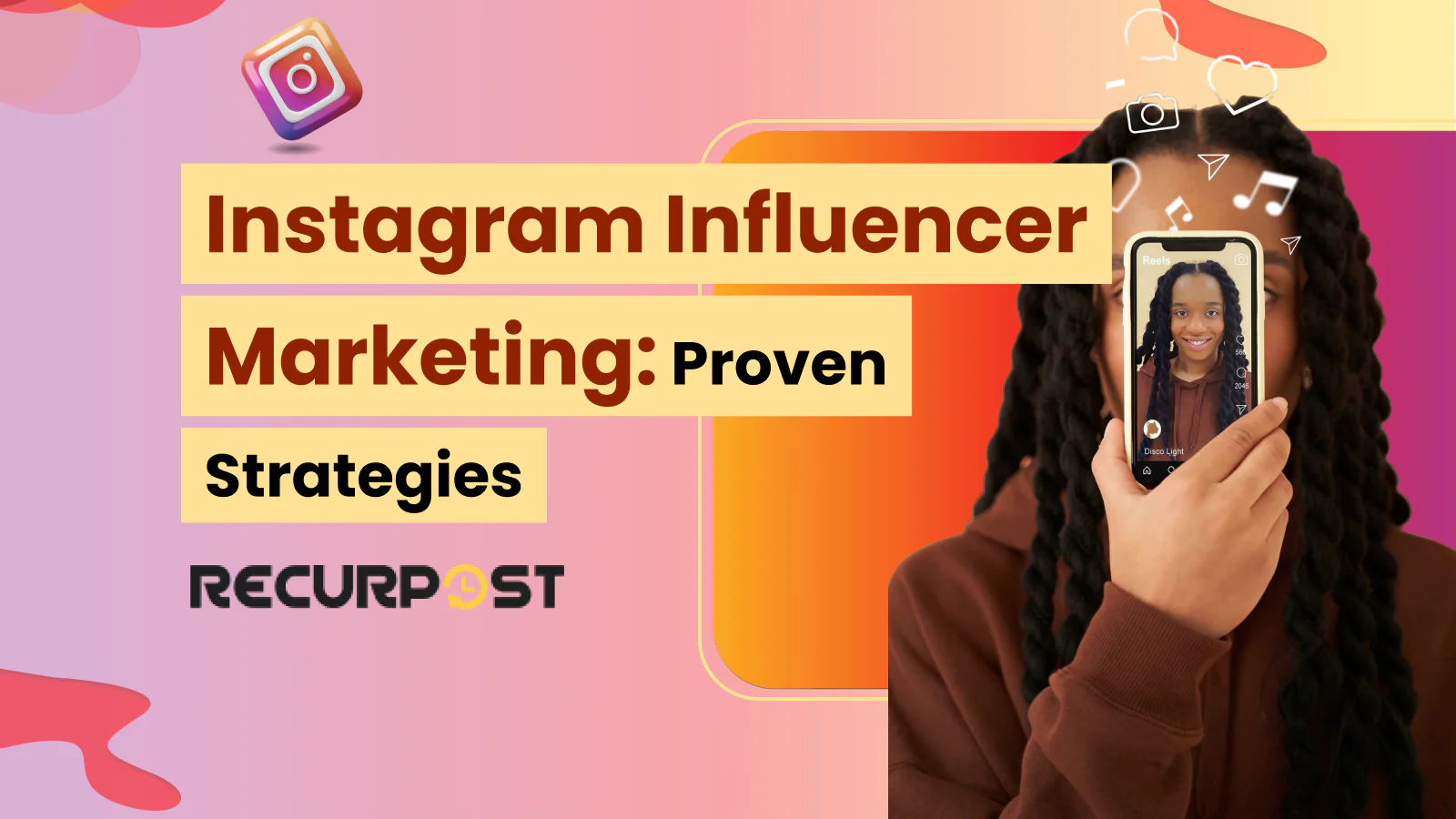Instagram Influencer Marketing happens when brands partner with trusted Instagram influencers who already have the target audience. Instagram creators share products and services in their unique style through Reels, Stories, or posts, and their followers listen because of established trust. A single authentic recommendation can drive curiosity, spark sales, and even turn a brand into part of someone’s daily routine.
The scale of influencer marketing is massive: the global influencer marketing industry now exceeds $33 billion, and Instagram remains its core. The platform blends product discovery, authentic content, and community interaction into one space.
According to Statista, 69% of consumers trust social media influencers’ recommendations when making purchasing decisions, proving that creator-led posts outperform traditional ads.
You’ll learn
- How Instagram Influencer Marketing has evolved and why this highly effective strategy continues to deliver strong campaign outcomes
- How to choose the right Instagram influencers and align with your target audience
- Budgeting methods that maximize ROI and strengthen brand growth
- Data-driven tactics that improve engagement rate and generate measurable results
- Key benefits of creator-led content and long-term influencer partnerships
- The most relevant Instagram influencer marketing trends for 2025 that shape social media campaigns
To run a successful Instagram Influencer Marketing strategy, set clear campaign goals, define your target audience, and work with the right Instagram influencers. Establish a realistic budget, manage your spending, and track engagement plus conversions using reliable analytics. This ensures brands can achieve measurable campaign outcomes across social media platforms.
Instagram Influencer Marketing campaigns thrive because the platform works as a trusted marketplace where users rely on creator recommendations in Stories, Reels, and posts. It merges entertainment with shopping, making it the go-to place for brands to connect with potential customers and influence purchasing decisions.
- People are already in discovery mode: Users exploring hashtags or the Explore page are curious and more open to product recommendations from trusted creators.
- No app-hopping needed: Shoppable tags enable users to see, like, and buy products within seconds without switching platforms.
- Multiple content formats = more storytelling freedom: Short Reels, disappearing Stories, and saved carousels give brands multiple storytelling options.
Did you know? 61% of users head to Instagram when they’re thinking about their next purchase (Sprout Social). That’s higher than Facebook or Twitter.
Instagram Hashtag Generator for Influencers
Get noticed by the right audience with AI-curated, influencer-specific hashtags.
This free tool generates high-performing hashtags tailored to your niche, whether you’re in fashion, fitness, beauty, travel, or lifestyle. Just drop your topic, and AI does the rest.
⭐ 4.3/5 average user rating (based on 2,000+ reviews)
“I finally reached the right audience, my engagement jumped in just a few posts.” – Lifestyle Influencer
From Celebrity Promos to Creator-Led Storytelling
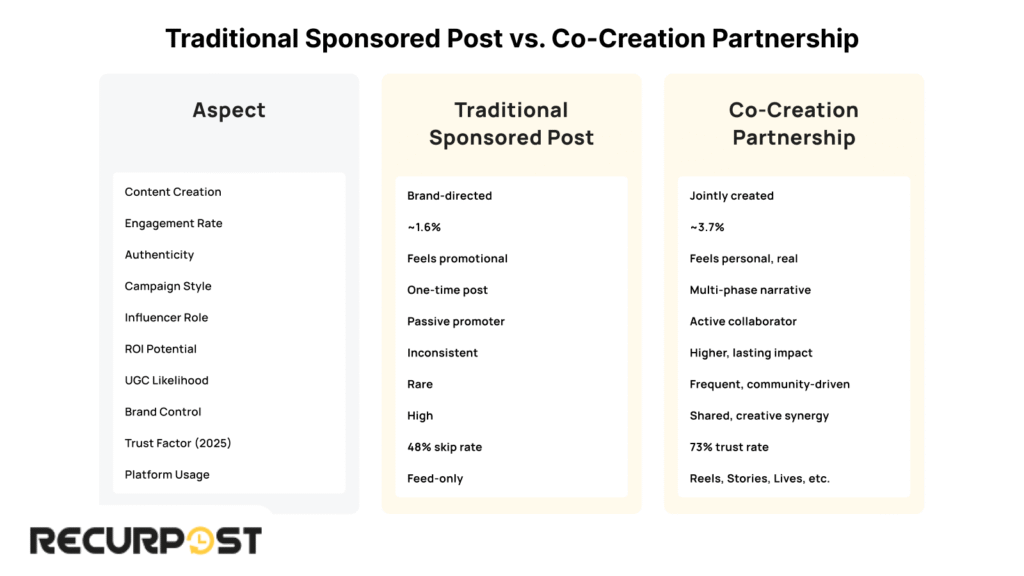
In 2025, Instagram Influencer Marketing reflects a major shift. Instead of relying on celebrity endorsements, brands now invest in influencer partnerships with creators who share genuine experiences. Audiences respond to authentic content from relatable Instagram influencers, making it more persuasive than scripted ads.
Micro influencers and nano influencers with smaller but loyal communities connect personally and tell meaningful stories instead of pushing polished ads. Best practices in Instagram influencer marketing campaigns emphasize relatability and engagement quality rather than follower counts.
A successful Instagram influencer marketing campaign requires transparent, long-term partnerships. Using clear disclosure tags like #ad or #sponsored builds brand safety and trust. This authentic approach drives higher engagement and sales, with Instagram being the ideal platform for sharing these impactful stories.
“People buy from creators they trust, not the loudest voice in the room, but the most relatable influencer.”
Micro influencers and nano influencers may have smaller reach, but they deliver stronger consumer trust and long-term brand relationships. Their tight-knit communities make recommendations feel personal, boosting campaign outcomes.
ROI Insights: Micro influencers and nano influencers provide higher ROI and ROAS by keeping costs low while driving strong engagement rates. Brands working with nano influencers see up to a 60% lift in response compared to celebrity partnerships, strengthening brand growth.
2025 Trend Alert: AI-powered platforms for influencer discovery now identify the right Instagram influencers by analyzing niche relevance, audience sentiment, and campaign goals. Tools like Upfluence, Julius, and Modash use machine learning to improve influencer marketing efforts and boost measurable campaign performance.
This evolution in trust and technology sets the stage for the next vital step: choosing the right influencer partner for your Instagram influencer marketing strategy, since fit always beats fame in driving campaign success.
Choosing the Right Instagram Influencer: Why Strategic Fit Matters
Relatability creates trust, but strategic fit is what drives Instagram Influencer Marketing campaign success. Choosing mismatched influencers risks damaging brand fit, confusing messaging, and attracting followers who won’t convert. Well-matched influencer partnerships generate higher engagement quality, broader reach, and stronger campaign outcomes.
Instagram Influencer Tiers and Their Strategic Purpose
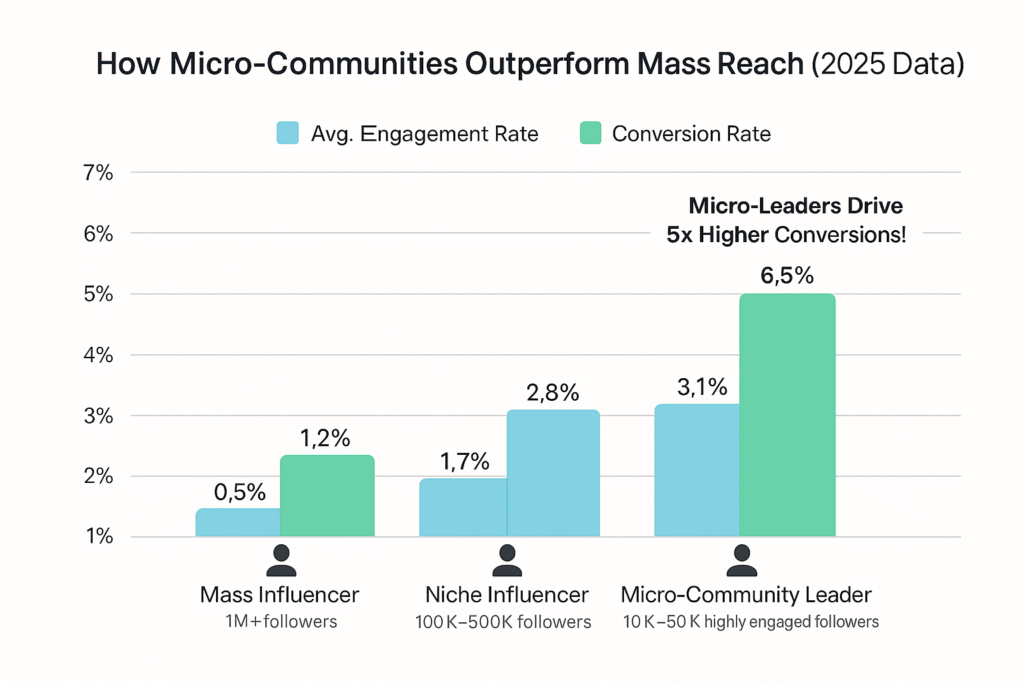
Instagram influencers fall into different tiers based on follower count, but numbers don’t equal results. Prioritize fit, relevance, and content style when building an influencer marketing strategy.
| Tier | Follower Count | Ideal Use Case |
| Nano Influencers | 1K–10K | Hyper-local reach, niche audiences |
| Micro Influencers | 10K–100K | High engagement, authentic content |
| Macro Influencers | 100K–1M | Industry authority, moderate reach |
| Mega/ Celebrity Influencers | 1M+ | Brand awareness, large-scale buzz |
This tiered approach stretches marketing budgets and improves chances of building genuine customer connections. Selecting relevant influencers based on audience alignment, engagement quality, and brand values becomes a proven driver of brand growth.
Evaluating Instagram Influencer Authenticity and Audience Relevance
Selecting the right Instagram influencers goes beyond follower count. Brands must check how influencers engage with their communities, whether their followers match the target audience, and if past content aligns with brand values. For instance, in a vegan snack campaign, working with a creator who recently promoted non-vegan products would break brand fit and harm campaign credibility.
Large follower counts don’t guarantee trust. Even macro influencers can underperform if their followers doubt authenticity. Brands use influencer marketing platforms like Upfluence, Heepsy, and Modash to analyze engagement quality, detect fake followers, review past partnerships, and confirm relevant influencers for stronger campaign performance.
Finding and Vetting Instagram Influencers: A Proven Selection Process
Building and managing Instagram Influencer Marketing campaigns requires specialized influencer marketing platforms. Tools such as Heepsy for influencer discovery, Upfluence for fraud detection, and Aspire for full campaign management streamline outreach, contracts, content approvals, and performance tracking. This structured process improves influencer marketing efforts and boosts measurable campaign outcomes.
| Tool | Best For | Features |
| Heepsy | Finding Niche Creators | Real-time audience quality, TikTok + IG integration |
| Upfluence | Avoiding fake followers | AI-powered fraud detection, influencer credibility |
| Aspire | End-To-End influencer campaign | Influencer outreach, Relationship management, Contract workflow |
| Modash | Vetting influencers across platforms | Real-time audience quality, Tik-Tok + IG integration |
| BuzzSumo | Content discovery and trend analysis | Identifies top-performing content and influencers within your niche |
| Creator.co | Small businesses and startups | Affordable plans, influencer marketplace, and automated campaign tools |
| Julius | Enterprise-level campaign management | CRM features, ROI tracking, and advanced analytics |
Instagram influencer marketing tools range from free discovery platforms to enterprise-level campaign management systems. Most provide features like influencer vetting, audience analytics, contract management, and ROI tracking, automating tasks that were once manual.
These influencer marketing platforms deliver data-driven insights, such as demographics and engagement quality. This information helps brands choose relevant influencers and build strong influencer partnerships. Once your creator team is in place, set a clear budget that supports measurable ROI and sustained brand growth.
Tip: Want to compare the best influencer marketing tools in one place? Check out our full breakdown to find what fits your brand strategy (and budget).
How to Discover the Right Instagram Influencers
Discovering Instagram influencers who drive results requires a clear Instagram Influencer Marketing strategy. Selecting relevant influencers within Instagram’s creator ecosystem is critical for campaign success. Here are four proven ways to find influencers that deliver strong campaign outcomes:
1. Hashtag Scouting
Browse hashtags your target audience follows, such as #CrueltyFreeBeauty or #HomeFitnessTips. Look for creators posting consistently with authentic engagement, meaningful comments, and active discussions. This signals a highly engaged audience that aligns with your campaign goals.
Example hashtag niches:
- Fashion:
#styleinspo,#ootd,#fashionblogger - Beauty:
#beautytips,#skincareroutine,#makeuptutorial - Tech:
#techreview,#gadgetlover,#techtips - Fitness:
#workoutroutine,#fitnessmotivation,#healthylifestyle
2. Competitor Check
Review competitor brand mentions or tagged posts. Creators already collaborating in your space may be relevant influencers with proven campaign performance. Always check exclusivity clauses before outreach.
3. Instagram Suggestions
Instagram’s AI-powered “Suggested for You” feature helps brands discover similar creators. These suggestions uncover up to 35% more relevant influencers than traditional searches, supporting smarter influencer marketing efforts.
Not All Influencers Are a Good Fit: How to Vet Them Before You Commit
Vetting the right Instagram influencers through a five-step process protects brands from wasted budgets, poor campaign performance, and off-brand messaging. This influencer vetting framework strengthens influencer marketing campaigns by ensuring only relevant influencers are selected.
Look for a Real Audience (Not Just Big Numbers)
Bots and fake engagement remain prevalent; avoid surface-level statistics.
- Engagement ratio: Healthy ranges sit between 1:3 and 1:6 (one like/comment per 3–6 followers).
- Growth curve: Use tools like SocialBlade to check if their following grew steadily or spiked overnight.
- Comment quality: Are followers dropping honest thoughts or just emojis?
- Red flag: Over 10K followers with under 1% engagement? Probably not a real influence.
Judge the Content (Not Just the Aesthetic)
You’re not renting ad space, you’re aligning with a creator’s voice. Ensure content aligns with brand safety and tone.
- Is their visual style at least an 80% match with your brand?
- Do their captions sound personal, not robotic?
- Are their Reels and Stories driving engagement quality or just filler?
Tip: Reels usually pull 2.3x more engagement rates than static posts. Compare how they perform across formats.
Double-Check Brand Safety and Value Match
A single misaligned post can damage influencer partnerships.
- Review the last 6 months of their posts for anything off-brand or controversial.
- Rate brand fit from 1 to 10.
- Have they recently promoted a competitor? If yes, tread carefully.
- Scroll through their comments. Are they trusted, or does it feel off?
Ask for the Numbers That Matter
Request platform-verified performance statistics with context rather than glossy screenshots.
- Ask for platform-verified performance stats.
- A solid reach-to-follower ratio is around 30%+.
- Instagram influencer conversion rate: 70%+ story completion.
- 1.5–3% click-through rates on branded links, which represent standard performance benchmarks
Look Into Past Partnerships
Past collaborations reveal reliability in influencer marketing efforts.
- Review at least five recent brand collabs.
- Message 2–3 past brands (if possible) for honest feedback.
- Were deadlines met? Did the content match the brief?
- Did they bring fresh ideas or go off-brand?
Instagram Influencer Outreach Process
Approaching influencers as creative collaborators rather than transactional partners increases response rates by 68% when following this 4-step outreach sequence.
Step 1: Warm Up With Intentional Engagement
Before outreach, interact with 3–5 posts from Instagram influencers over a week. Leave meaningful comments, share their Stories, or respond thoughtfully. Avoid generic emojis. This consistent engagement builds trust so your message feels like a genuine brand partnership request instead of cold outreach.
Step 2: Send a DM That Feels Human
Once on their radar, send a short, personalized DM. Mention a specific post that stood out. Personalization signals authenticity and helps secure influencer partnerships that align with brand fit.
Here’s a simple message you can tweak:
DM Template:
Hi [Name], I’m [Your Name] from [Brand]. I enjoyed your recent post about [insert specific post or topic], loved how you [compliment or comment].
We’re launching an Instagram influencer marketing campaign to showcase [product/service]. Your content feels like a strong match for our campaign goals. Would you be open to details? I can also switch to email if easier.
Step 3: Follow Up with a Formal Proposal
Once they reply with interest, move the conversation to email; it’s easier to keep things organized and professional. Keep the tone warm and collaborative.
In your first message, include the essentials:
- Campaign goals and messaging
- Deliverables: Spell out what you’re looking for, like 2 Reels + 3 Stories, or one carousel post + 1 Story with a link.
- Compensation: Be upfront. Whether it’s a flat fee, affiliate bonus, gifted product, or a mix, clarity builds trust.
- Timeline: Set expectations for drafts, posting dates, and reporting windows.
- Creative direction: Include must-haves like tone, style, hashtags, visual vibe, or what to avoid.
- Performance expectations tied to KPIs
This transparency builds trust and strengthens long-term influencer partnerships.
Step 4: Finalize It with a Contract + Quick Onboarding
Once they’re in, get everything in writing. A well-drafted agreement makes things clear and prevents miscommunication. Document all agreements in writing to maintain clarity and to avoid miscommunication.
Key details to include:
- Usage rights: 76% of brands now ask for at least 6 months of content usage. State your expectations up front.
- Payment terms: For example, 50% upfront, 50% on delivery.
- Exclusivity: If you want them to hold off on promoting similar brands during the campaign, say so.
- Content ownership: Can you reuse their content in ads or on your site? Make that clear.
- FTC compliance: Ensure posts are tagged correctly with #ad, #sponsored, or utilize branded content tools as necessary.
Bonus tip: Include a short onboarding doc or record a quick Loom video walking them through the next steps. It reduces back-and-forth and helps creators feel confident, aligned, and ready to create.
“Without data, you're just another person with an opinion.” W. Edwards Deming.
Calculate Instagram Influencer Marketing Cost Before Collaboration
Many brands make the mistake of only calculating post fees when planning their Instagram Influencer Marketing spend. This narrow view causes overspending on low-performing creators or missing top influencers due to poorly allocated marketing budgets.
Benefits of Well-Planned Budgeting:
1. Predictable campaign performance: Clear budgets improve forecasting of campaign outcomes.
2. Improved ROI: Balanced spending increases measurable returns.
3. Clear communication: Teams understand budget flows and resource allocation.
4. Manageable scaling: Growth becomes easier and less risky when the influencer marketing strategy is budget-aligned.
Consequences of Poor Budgeting
1. Wasted Resources: Without a precise budget, you may quickly exhaust your funds without seeing significant results.
2. Ineffective Influencer Choices: You might partner with influencers who fail to make an impact on your campaign.
3. Difficulty in Accountability: It can be challenging to explain where the money has gone and the reasons behind those expenditures.
4. Complicated Mid-Campaign Adjustments: Making changes during a campaign can become messy or even impossible without a clear budget framework.
Advantages of Smart Budgeting:
1. Data-driven decisions: Metrics like Cost per Engagement (CPE) and ROMI guide smart spending.
2. Tier-based allocation: Distributing spend across influencer tiers avoids dependence on one group.
3. Experimentation: Test formats such as Reels, giveaways, or seasonal campaigns.
4. Long-term savings: Tools and automation reduce manual work and improve ROI.
Bottom line: Budgeting in Instagram Influencer Marketing campaigns isn’t just about cutting costs. It provides structure, clarity, and long-term stability. Smart financial planning ensures brands achieve meaningful campaign outcomes, measurable ROI, and sustained growth through content-driven promotions.
Build a Data-Driven Instagram Influencer Marketing Strategy That Converts
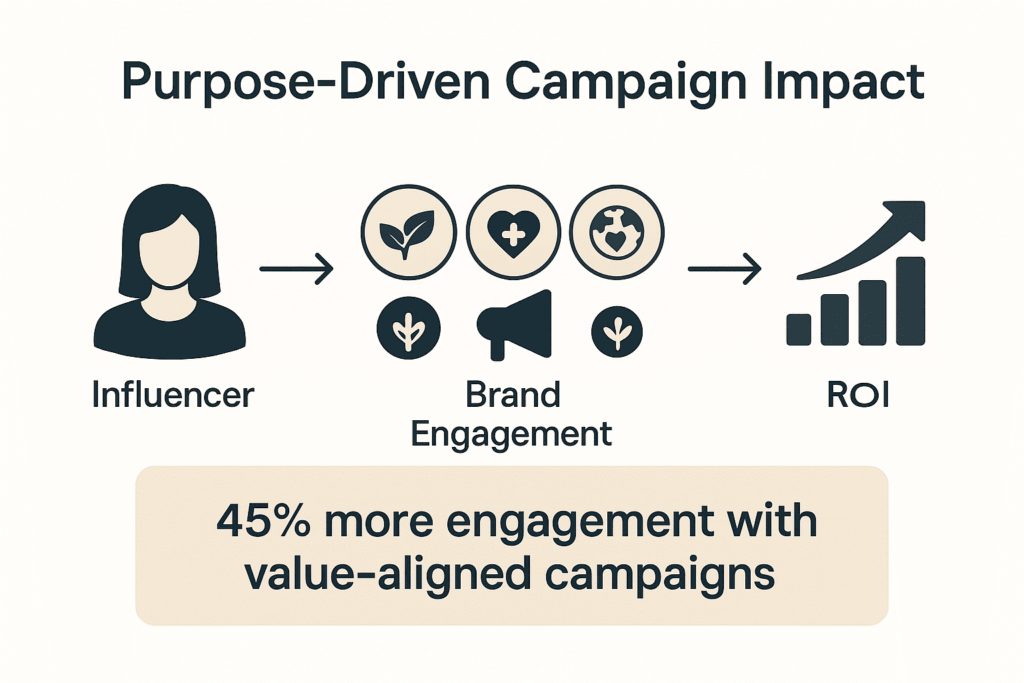
Successful Instagram Influencer Marketing campaigns require solid planning and data-driven performance tracking. Instead of guesswork, brands must tie each campaign to measurable campaign outcomes like awareness, product sales, lead growth, or app installs—always guided by defined campaign goals and metrics.
Start With a Clear Goal (Aligned with Business Outcomes)
Before selecting an Instagram Influencer, ask yourself the following questions:
- Are you launching something new or revitalizing an existing offer?
- Are you aiming to drive traffic, boost conversions, or enhance social credibility?
- Is this a short-term initiative (a one-off campaign) or part of a long-term influencer marketing strategy?
Examples of Effective Goals:
- Increase site visits by 25% within 30 days.
- Achieve a 4% engagement rate on sponsored posts.
- Acquire 500 new email sign-ups through Story links.
- Generate 100 sales using a creator-specific promo code.
Next, Track the Right Key Performance Indicators (KPIs)
Your goals will guide the metrics you track:
- Reach / Impressions: How many people viewed the content?
- Engagement: How many likes, comments, shares, or saves did it receive? Did it resonate with the audience?
- Click-Through Rate (CTR): Did audiences take the desired next steps?
- Conversion Rate: Did users sign up, make a purchase, or download your offering?
- Return on Investment (ROI) / Return on Ad Spend (ROAS): Was the financial outcome worth the investment?
Defined targets and metrics direct creator selection, content development, and budget allocation beyond performance tracking.

Choose no more than 2–3 core metrics per campaign. Trying to track everything can lead to analysis paralysis.
Choose the Right Content Format (Reels, Stories, Carousel)
Instagram content formats have different purposes in the marketing funnel. Successful campaigns match goals, influencers, and formats for the best results.
| Format | Best For | Why It Works |
| Reels | Reach, virality, engagement | Short-form, algorithm-friendly, highly shareable |
| Stories | Direct traffic, limited-time offers | Swipe-ups, polls, urgency, great for CTAs |
| Carousels | Education, tutorials, product showcases | More space for storytelling and product info |
| Lives | Deep engagement, Q&A, launches | Real-time connection builds trust and community |
2025 Insight: Reels with a CTA in the first 3 seconds deliver 27% higher interaction level than those that don’t. Keep your call to action short, visual, and early.
Use UTM Links, Discount Codes & Hashtag Tracking
Use data to guide your decisions and let go of what doesn’t work. Making choices based on data helps you scale, while relying only on gut feelings can lead to costly mistakes if you don’t track the results.
Use influencer marketing tools to see what’s moving the needle:
- UTM links to trace clicks from each influencer
- Branded hashtags to monitor campaign buzz and user-generated content (UGC)
- Unique promo codes to tie purchases back to individual creators
- Influencer marketing tools or dashboards like RecurPost, to compare performance side by side
Squeeze More Value From Great Content
High-performing influencer posts shouldn’t disappear after 24 hours. Reuse them to be consistent and maximize returns:
- Turn them into Facebook or Instagram ads
- Feature in product pages or landing banners
- Use as email headers or scroll-stopping CTAs
- Repost with new captions, angles, or offers
Instagram influencers promote products and services by featuring them naturally in posts and Stories. They track sales through unique promo codes and links, repurposing this authentic content across social media platforms.

Always negotiate content usage rights before the campaign starts. This allows you to reuse influencer content legally in paid media or branded placements.
What’s Working for Successful Influencer Marketing: Less Promotion, More Participation
Instagram Influencer Marketing efforts evolve as audience reactions shift. What worked in 2022 may not drive results in 2025. Today, brands succeed by building long-term influencer partnerships rather than relying on single promotions. Audiences demand authentic collaboration and genuine relationships with Instagram influencers, not just polished product placements.
From Ad Spots to Collaborations That Feel Real
Marketing has shifted from static ads to co-created content, with audiences actively participating in the influencer marketing campaigns they follow.
Leading brands are doing it by:
- Early Engagement: Brands are involving Instagram influencers in the product design process before it launches.
- Authentic Content Storytelling: Creators are sharing behind-the-scenes looks and personal experiences with products instead of staged ads.
- Interactive Formats: Live sessions and Q&As allow audiences to engage with brands directly.
- Creative Collaborations: Co-developing names, pricing, and designs for stronger audience alignment
This shift not only boosts engagement but also increases honesty, driving long-term brand trust and stronger campaign outcomes.
Campaigns featuring co-created content generate 2.3x more user interaction on average than traditional sponsored posts.
Consumers don’t just want to be sold to; they want to witness the journey. Co-creation turns campaigns into stories worth following.
Why Co-Creation Wins (and What to Watch For)
Audiences respond positively to creators who demonstrate genuine brand connections.
Co-created content brings:
- More trust: When influencers genuinely believe in what they’re sharing, it doesn’t feel like an ad; it feels like a recommendation.
- Real engagement: Behind-the-scenes clips, Q&As, and collaborative content spark conversations that go beyond the “like” button.
- Lasting impact: Co-creation often means repurposable content, such as UGC, organic mentions, and even media pickups, long after the campaign ends.
- Stronger brand recall: Deep influencer partnerships don’t just sell, they stick. They help people remember who you are and why you matter.
Co-creation partnerships require time and investment to develop effectively.
Trade-offs to expect:
- It takes time: Co-creation isn’t plug-and-play. There’s back-and-forth, brainstorming, and often multiple content drafts.
- More hands in the kitchen: Contracts need to be clear on rights, revisions, and expectations from both sides.
- You’ll have to share control: Creators know what resonates with their followers, so be ready to give them space to shape the narrative.
Your 2025 Move:
Stop asking, “What should this influencer say about our product?”
Start asking, “What can we build together that their audience will love and trust us for?”
Rise of AI-Generated Influencers and Virtual Creators
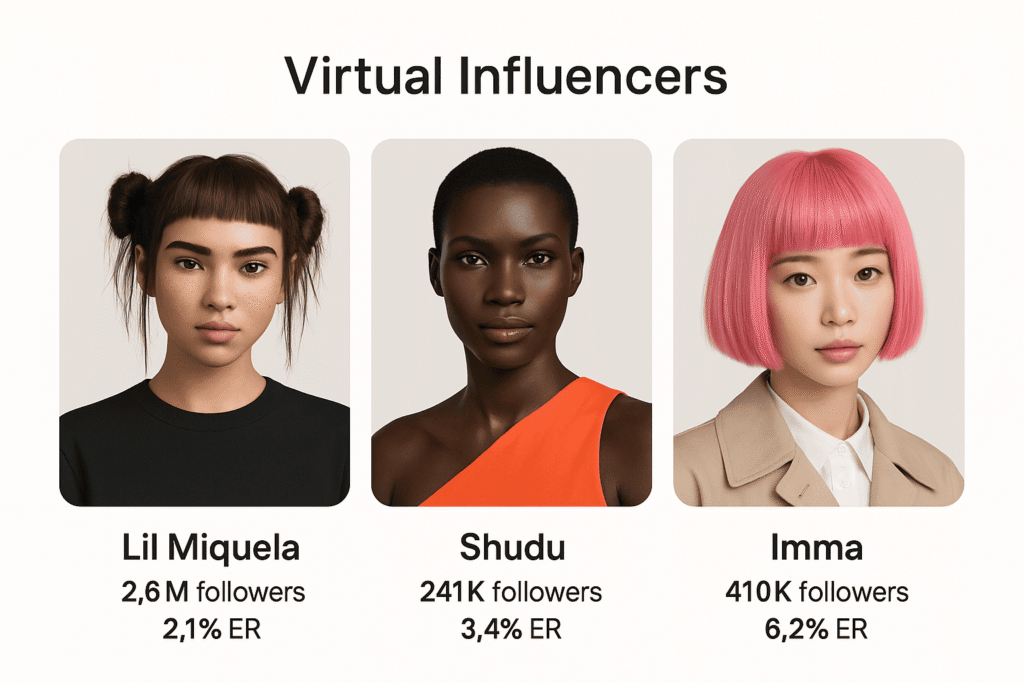
AI-generated influencers are reshaping the influencer marketing industry, leading major fashion, beauty, and tech campaigns alongside human creators. These digital personalities provide consistent brand messaging, avoiding controversies, delays, and brand safety risks common with traditional partnerships.
Why brands are buying in:
- Engagement that rivals authentic influencers: Digital stars like Lil Miquela and Shudu pull in millions of followers, and the interaction isn’t just vanity metrics. Their audiences comment, share, and even build fandoms around them.
- Complete creative control: Brands can shape every aspect, from personality to visuals, ensuring consistency in messaging down to the smallest detail, including emojis.
- Scalable and always accessible: These creators don’t require flights, avoid time zone challenges, and experience no burnout. They are available 24/7 worldwide, free from the limitations of human constraints.
AI influencers generate a measurable marketing impact despite their synthetic nature..

Virtual influencers have 30% higher engagement rates on average than human influencers in sponsored posts, especially among Gen Z and younger millennial audiences who value futuristic, novelty-driven experiences.
Where they work best:
- Product launches in AR/VR environments
- Interactive digital fashion shows or app experiences
- Campaigns where visual perfection and narrative control are key
“AI-generated influencers don’t replace humans—they redefine what’s possible in Instagram influencer marketing strategy and brand storytelling.”
AI-powered platforms give brands scalability, reliability, and creative freedom beyond human limits. Success requires transparent disclosure of their artificial nature to maintain audience alignment and long-term authenticity focus.
From Mass Appeal to Micro-Communities
In 2025, Instagram Influencer Marketing strategies will prioritize targeted communication over mass appeal. Success comes from micro-communities, groups sharing values, lifestyles, and interests. A sustainable skincare brand, for example, can partner with micro-influencers to teach Gen Z about clean beauty. This approach builds authenticity focus, creating trusted conversations instead of generic advertising.
Why micro-communities outperform mass influencers:
- Audiences feel seen and understood, not just marketed to.
- Content comes off as genuine and tailored, not generic.
- Engagement is deeper, and followers are more likely to comment, share, and take action on recommendations.
How to tap into this trend:
- Collaborate with niche influencers aligned with your target audience.
- Prioritize shared values over pure aesthetic fit.
- Empower creators to build community-first content, Such as educational Reels, day-in-the-life tutorials, Q&As, or product challenges.
Short-Form Video: The Undisputed King of Engagement
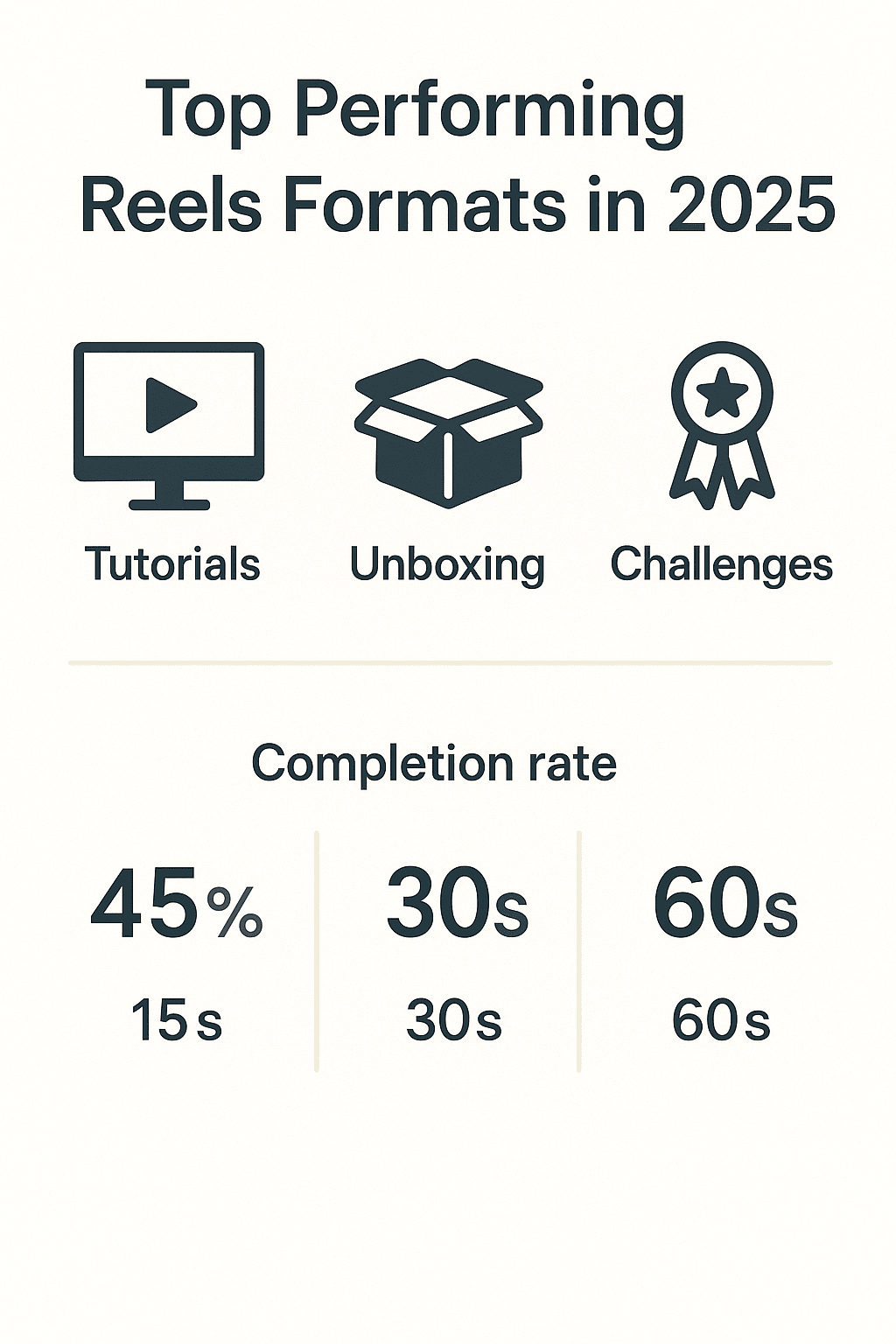
In 2025, Instagram Influencer Marketing campaigns center on Reels and short-form video dominance. Users reward brands that deliver concise messages under 30 seconds while scrolling. Static images still matter for aesthetics, and long captions work for storytelling, but short-form video dominates reach, ROI, and campaign performance.
Why Reels Win Big:
- Instagram’s algorithm favors Reels: They show up first in Explore and get pushed harder in feeds.
- Mobile-first behavior rules: People want content that fits into their day, while commuting, waiting in line, or between tasks.
- Shorter attention spans = better performance: Videos under 60 seconds have a 150% higher completion rate than longer formats (Meta, 2025).
Formats That Work Right Now:
- Tutorial Reels: Creating Instagram influencer content involves tutorial Reels showing product usage, behind-the-scenes Stories that build authenticity, carousel posts for educational content, and unboxing videos that demonstrate genuine first reactions.
- Trend Mashups: Pair trending audio with your product in clever ways. Think memes, transitions, or relatable moments that feel native to the platform.
- Branded Challenges: Launch a Reel challenge with an influencer, get users involved, and amplify reach with user-generated content.
- Quick Demos & Unboxings: Highlight key features, do a before/after, or show the product in action. Keep it snappy, real, and scroll-stopping.
Boost Instagram influencer marketing campaigns with paid promotion. Spark-style ads expand reach to targeted audiences, enhancing ROI and campaign outcomes.

Ask influencers to create authentic content through “day in the life” Reels or genuine first reactions. Raw, unfiltered clips often outperform polished ads in engagement rate and meaningful engagement.
“Don’t interrupt what people are interested in. Be what they’re interested in.”
What Brands Should Do Now
If Instagram is doubling down on video, your brand should follow suit.
- Shift your content mix: Prioritize short-form Reels, especially for product launches, flash sales, or seasonal drops. These moments thrive on urgency and shareability.
- Equip influencers to succeed: Give them branded filters, sounds, and visual cues to maintain consistency while letting their voice shine through.
- Track what matters: Monitor more than just likes. Optimize based on watch time, shares, saves, and retention rate. These signals are real interest, not vanity engagement.
When brands embrace video-first algorithms, they convert attention into measurable campaign performance and ROI.
Purpose-Driven Campaigns Are Winning Hearts (and Sales)
Successful Instagram Influencer Marketing strategies in 2025 highlight brand purpose alongside products. Today’s consumers prioritize values when purchasing. Brands that skip purpose-driven campaigns risk losing loyalty and long-term brand growth in the competitive influencer marketing industry.
Why This Shift Matters
- 72% of Gen Z and Millennials are more likely to buy from brands that align with causes they believe in
- Influencers who advocate for values see 45% higher engagement rates when promoting aligned products
Real-World Examples of Purpose-Driven Influencer Campaigns:
- A skincare brand partners with eco-conscious creators to launch a plastic-free packaging initiative, complemented by educational Reels on ocean waste.
- A jewelry label partners with mental health advocates, donating 10% of each sale during Mental Health Awareness Month, and inviting followers to share their self-care routines.
- A fashion brand creates a co-authored campaign with body-positive influencers, spotlighting slow fashion and garment worker rights.
“People don’t just want to buy what you make, they want to buy into why you make it.”
What Brands Should Start Doing:
- Select relevant influencers who authentically support social or environmental change
- Tie influencer marketing campaigns to measurable real-world impact (donations, community projects, zero-waste)
- Share results transparently: amounts raised, communities impacted, changes achieved. Transparency builds trust, drives measurable results, and fosters stronger campaign outcomes
Key Brand Benefits:
Purpose + authenticity → standout differentiation in a saturated market, solid tracking tools, and a reliable way to calculate ROI.
Emotional connection → long-term loyalty
Meaningful storytelling → organic word-of-mouth and PR pickup
Key Performance Indicators You Should Track
In Instagram Influencer Marketing campaigns, campaign goals define which KPIs matter most. Tracking the right metrics ensures measurable results and stronger campaign outcomes.
| Objective | Primary KPIs | Secondary KPIs |
|---|---|---|
| Brand Awareness | Reach, Impressions, Follower Growth | Story Views, Profile Visits |
| Engagement | Engagement Rate, Comments, Saves | Share Rate, Comment Sentiment |
| Conversions | Click-through Rate, Conversion Rate, CPA | Average Order Value, Customer Lifetime Value |
Want to measure influencer engagement? Use this formula:
Engagement Rate = (Likes + Comments + Saves + Shares) ÷ Follower Count × 100
For context, nano-influencers (1K–10K followers) typically pull in a 4–5% engagement rate, often thanks to their tight-knit, loyal audiences. Macro-influencers (100K–1M) average closer to 1.3%, due to broader but less intimate reach.
Tip: Use UTM links and promo codes to attribute clicks, sign-ups, and purchases in Instagram influencer marketing efforts, ensuring precise ROI tracking.
Implementing Proper Attribution in Instagram Influencer Marketing
To identify the right Instagram influencers who deliver measurable results, brands must look beyond surface-level engagement. Proper attribution supports scaling Instagram Influencer Marketing efforts, strengthening influencer partnerships, and improving long-term campaign outcomes.
1. Unique Promo Codes
Assign every influencer a code (e.g., INFLUENCER20). This ensures clear attribution, tracking direct conversions, and calculating precise ROI from influencer campaigns.
UTM Parameters
utm_source=instagram
utm_medium=influencer
utm_campaign=spring_sale
utm_content=alex_smith
Plug these into your analytics platform to see exactly who’s sending the clicks.
2. Instagram Shopping Tags
Using product tags in influencer posts? Smart move. Instagram Insights shows that tagged products get 35% higher conversion rates than links in bios. Always track those taps.
3. Custom Landing Pages
Build dedicated pages for each influencer, like: (recurpost.com/partner/alex-smith), This page helps you analyze behavior, traffic sources, and conversions at the individual partner level.
4. Meta Pixel Tracking
Install Meta Pixel to capture delayed conversions from Instagram influencer marketing campaigns. This method identifies up to 22% more attributable conversions compared to standard link tracking, improving overall campaign performance.
Calculating True ROI for Instagram Influencer Campaigns
ROI (Return on Investment) is a key metric for measuring the effectiveness of Instagram influencer marketing. The formula for calculating ROI is:
ROI = [(Value of Conversions − Campaign Cost) ÷ Campaign Cost] × 100
Here’s a practical example to illustrate the concept:
- Campaign Cost: $5,000 (This is calculated as 5 influencers at $1,000 each)
- Conversions: 150 new customers
- Average Order Value (AOV): $85
- Total Revenue: 150 customers × $85 = $12,750
Using the formula, we can calculate the ROI as follows:
ROI = [(12,750 − 5,000) ÷ 5,000] × 100 = 155%
In addition to calculating ROI for direct conversions, it’s also important to account for upper-funnel metrics when measuring brand awareness or engagement campaigns. Here are some standard valuations for these metrics:
- 1,000 new followers: approximately $500 (based on average organic acquisition costs)
- 10,000 engagements: about $1,000 (comparable to paid engagement rates)
- 100,000 impressions: roughly $1,500 (based on CPM benchmarks)
This ROI framework helps brands assess both financial return and broader Instagram influencer marketing efforts, ensuring measurable results across all campaign levels.
Tools for Smarter Influencer Performance Tracking
Influencer marketing tools streamline tracking, enabling brands to measure Instagram Influencer Marketing efforts with accuracy. These tools plug into platforms like RecurPost for centralized reporting.
| Handle influencer CRM, contracts, and payments | Function | How RecurPost Helps |
|---|---|---|
| Native Instagram Analytics | See reach, impressions, saves, and story views | RecurPost pulls in key metrics for campaign reports |
| Google Analytics | Track influencer traffic and conversions | RecurPost visualizes GA data alongside content metrics |
| Link Shorteners | Monitor bio link clicks and UTM campaigns | RecurPost auto-generates and tracks shortened URLs |
| Influencer Platforms | RecurPost complements scheduling and analytics | RecurPost complements with scheduling and analytics |
With RecurPost’s analytics dashboard, brands gain a unified view of influencer campaigns: engagement trends, growth spikes, post timing, and overall campaign performance. This supports precise ROI tracking and measurable results.
Case Study: How STYLE&CO Scored a 155% ROI with RecurPost
Fashion brand STYLE&CO launched a 4-week Instagram influencer marketing campaign with eight micro-influencers. RecurPost managed scheduling, tracking, and analytics to streamline the influencer campaign workflow.
What They Did:
- Set up individual UTM links per influencer
- Built custom landing pages for attribution
- Issued unique promo codes to each influencer
- Used RecurPost to schedule posts and monitor performance
Results:
- 22,500 unique visitors from influencer content
- 450 conversions (2% CVR)
- $32,400 revenue generated
- 155% ROI on a $12,700 spend
- 3,200 new Instagram followers
RecurPost’s advanced tracking, scheduling, and reporting tools strengthen Instagram Influencer Marketing efforts, delivering measurable ROI and scalable results for brands.
Common Mistakes That Sabotage Influencer ROI
In Instagram Influencer Marketing campaigns, brands often make mistakes that hurt ROI, weaken campaign performance, and block scalability.
- Chasing Vanity Metrics: Prioritizing likes over measurable results such as conversions and ROI.
- Single-Touch Attribution: Ignoring multi-channel journeys, underestimating the true impact of influencer campaigns.
- Inconsistent Tracking: Weak attribution systems damage insights and compromise Instagram influencer marketing efforts.
- Skipping Baseline Benchmarks: Without benchmarks, brands can’t compare pre- vs post-campaign outcomes.
- Manual Data Management: Spreadsheets slow influencer marketing strategy and block scalable campaign performance.
RecurPost users typically save an average of 5.5 hours per week on influencer reporting and achieve up to 28% greater accuracy in attribution compared to those managing it manually.
Utilize Built-In and External Tools for Success:
Incorporating external tools can centralize data beyond Instagram’s native insights, enabling deeper analysis of campaign performance.
| Tool | What It Tracks |
| Google Analytics 4 | On-site behavior, goal conversions, and session time |
| Instagram Insights | Impressions, reach, shares, story taps |
| Bitly / Rebrandly | CTRs and geographic traffic data |
| Grin / Aspire / Upfluence | End-to-end influencer campaign ROI |
| UTM.io | Custom UTM tracking made easy |
Benchmark Campaign Success, Then Optimize
To evaluate Instagram Influencer Marketing campaigns, compare your performance data against industry benchmarks and past results. This ensures measurable results and scalable campaign performance.
- Industry Average Engagement Rates:
- Approximately 2% for macro influencers
- Approximately 5-8% for micro influencers
- Cost-Per-Engagement (CPE): Understand the norms based on your niche and the influencer tier.
- Typical Influencer ROI: Many brands aim for a return of $5 or more for every $1 spent.
Next Steps for Optimization:
- A/B Test: Compare UGC vs. professional content for measurable insights
- Repurpose: Turn high-performing influencer posts into ads to scale ROI
- Double Down: Invest in creators driving high ROI and campaign outcomes
- Cut Losses: Adjust contracts or remove underperformers to protect marketing budgets
Tracking the right key performance indicators (KPIs) will empower you to enhance your influencer marketing strategy effectively.
Conclusion: Make Influence Count, Not Just Impressions
Instagram influencer marketing requires authenticity, strategic planning, and measurable outcomes, with success depending on precise influencer selection, content co-creation, and data utilization. Prioritize long-term relationships, niche communities, and ROI-backed decisions over vanity metrics by building influence with intention rather than pursuing visibility alone.
Ready to elevate your next campaign? Start smart, scale fast, and let your impact speak louder than your reach.
FAQs on Instagram Influencer Marketing
1. Is Instagram influencer marketing still effective in 2025?
Yes, Instagram influencer marketing remains highly effective in 2025, especially with the rise of micro and nano influencers. Engagement rates are higher when brands focus on niche communities rather than follower counts. Authenticity and relatable storytelling drive conversions more than polished ads.
2. How do I find the right influencer for my brand on Instagram?
Define your audience, campaign goals, and budget. Use Instagram influencer marketing tools like Heepsy, Modash, or Instagram Collab features. Prioritize audience alignment, content style, and trust. Look past follower count and focus on campaign outcomes, not vanity metrics.
3. What’s the average ROI of Instagram influencer marketing campaigns in 2025?
According to Tomoson’s Instagram influencer marketing study, the average ROI is $5.78 for every $1 spent, but top-performing campaigns can go even higher. Results depend on your targeting, influencer alignment, and campaign structure. Performance-based deals and UGC repurposing often boost ROI significantly.
4. What influencer marketing trends are shaping Instagram in 2025?
UGC-style content, AI-powered influencers, long-term partnerships, and cause-driven storytelling are dominating. Collaborative posts, Instagram Reels, and performance-based campaigns are gaining traction. Transparency, value alignment, and content quality matter more than ever.
5. Should I work with micro or macro influencers in 2025?
Micro-influencers (10k–100k followers) often deliver better engagement and trust, especially in niche markets. Macro influencers are great for reach and awareness, but may lack a tight-knit community impact. A hybrid strategy works best for most brands, mixing both depending on campaign goals.
6. How much do Instagram influencers charge in 2025?
Pricing varies, but micro-influencers typically charge between $100–$1,000 per post, while top-tier creators can demand $10,000+. Costs also depend on content format (Reels vs. Stories), exclusivity, usage rights, and campaign duration. Always negotiate based on deliverables, not just followers.

Fenil Patel makes complex topics simple and useful for readers who want clarity, value, and actionable takeaways. As an SEO content writer with 4+ years of experience, he creates blogs and website content that answer real questions, solve problems, and guide readers toward informed decisions. Whether it’s healthcare, fashion, or SaaS, Fenil’s writing is designed to give you practical insights while ensuring the information you read is trustworthy, engaging, and easy to apply.

